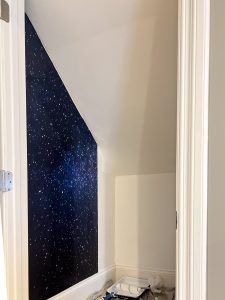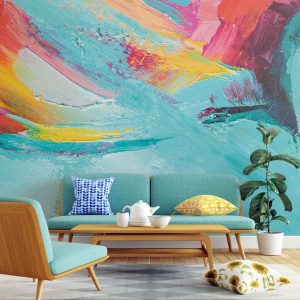Peel and stick murals have become increasingly popular for their ability to transform spaces with vibrant colors and captivating designs. However, one common challenge that homeowners face is color inconsistencies within the mural. These variations can detract from the overall aesthetic appeal and leave the mural looking patchy or disjointed.
A. The Appeal and Benefits of Peel and Stick Murals
Peel and stick murals offer a convenient and cost-effective way to add visual interest to any room. They are easy to install, removable, and require no messy adhesives or professional installation. Additionally, they come in a wide range of designs, from abstract patterns to realistic landscapes, catering to diverse tastes and styles.
B. The Challenge of Color Inconsistencies in Murals
Despite their many advantages, peel and stick murals can sometimes exhibit color inconsistencies. These variations can arise from several factors, including improper wall preparation, lighting conditions, batch differences in mural panels, and improper installation techniques. Addressing these issues is crucial to achieving a seamless and visually appealing result.
II. Common Causes of Color Inconsistencies
Understanding the root causes of color inconsistencies is the first step in resolving this issue. Here are some of the most common culprits:
A. Improper Wall Preparation
Failure to properly prepare the wall surface can lead to color variations in the mural. Uneven surfaces, residual paint, or dirt can create an uneven base, causing the mural panels to appear different shades or tones.
B. Lighting Variations
The way light interacts with the mural can significantly impact its perceived color. Different light sources, such as natural sunlight or artificial lighting, can cast varying hues and intensities, leading to color inconsistencies across the mural.
C. Batch Differences in Mural Panels
Peel and stick murals are often produced in batches, and slight variations in the manufacturing process can result in color differences between panels from different batches.
D. Improper Installation Techniques
Improper installation techniques, such as misalignment or stretching of the mural panels, can also contribute to color inconsistencies. Misaligned panels can create visible seams, while stretching can distort the colors and patterns.
III. Preparing Your Wall for Optimal Color Consistency
Proper wall preparation is crucial for achieving a consistent and visually appealing mural installation. Follow these steps to ensure your wall is ready:
A. Thoroughly Clean the Wall Surface
Start by thoroughly cleaning the wall surface to remove any dirt, grease, or residual paint. Use a mild detergent and a damp cloth to wipe down the entire area.
B. Repair Any Imperfections and Smooth the Wall
Inspect the wall for any imperfections, such as cracks, holes, or uneven surfaces. Use a spackling compound to fill in any gaps or crevices, and sand the area until it’s smooth.
C. Apply a Primer for an Even Base Color
Once the wall is clean and smooth, apply a high-quality primer designed for use with peel and stick murals. This will create an even base color and help the mural panels adhere properly, minimizing color variations.
IV. Evaluating Lighting Conditions
Lighting plays a crucial role in how colors are perceived, and it’s essential to consider the lighting conditions in the room where the mural will be installed.
A. Consider the Type and Direction of Light Sources
Assess the type of light sources in the room, whether natural or artificial, and their direction. Different light sources can cast varying hues and intensities, affecting the mural’s overall appearance.
B. Assess How Lighting Affects the Appearance of Colors
Observe how the lighting in the room interacts with the mural’s colors. Take note of any areas that appear washed out or overly saturated, and consider adjusting the lighting accordingly.
C. Tips for Optimizing Lighting for Color Consistency
To achieve optimal color consistency, consider the following tips:
- Use a combination of natural and artificial lighting to balance the color temperature and intensity.
- Install dimmable lighting fixtures to adjust the brightness and warmth of the light as needed.
- Position light sources strategically to minimize shadows and ensure even illumination across the mural.
V. Handling Batch Variations in Mural Panels
If you notice color differences between mural panels from different batches, there are strategies you can employ to minimize the impact.
A. Inspect Panels Before Installation
Before installing the mural, carefully inspect each panel and group them according to their color variations. This will help you plan the installation and strategically place panels to minimize noticeable differences.
B. Mix and Match Panels from Different Batches
Instead of installing panels from the same batch in a continuous sequence, mix and match panels from different batches. This technique can help blend the color variations and create a more seamless appearance.
C. Strategies for Blending Inconsistent Panels
If you encounter panels with significant color differences, consider the following strategies:
- Use a mural panel with a transitional color or pattern to bridge the gap between inconsistent panels.
- Strategically place accent pieces, such as artwork or furniture, to draw the eye away from the color inconsistencies.
- Embrace the variations and treat them as part of the mural’s unique character, creating a more organic and natural look.
VI. Proper Installation Techniques for Color Consistency
Proper installation techniques are essential for achieving a seamless and consistent mural. Follow these guidelines:
A. Work in Small Sections for Better Control
Instead of attempting to install the entire mural at once, work in small sections. This approach allows you to carefully align and smooth each panel, minimizing the risk of misalignment or stretching.
B. Align Panels Carefully to Avoid Color Mismatches
Pay close attention to the alignment of each panel, ensuring that the patterns and colors match seamlessly. Use a level or a straight edge to guide your installation and avoid misalignments that can create visible seams or color variations.
C. Use a Wallpaper Smoother to Eliminate Air Bubbles and Wrinkles
Air bubbles and wrinkles can distort the appearance of the mural and create color inconsistencies. Use a wallpaper smoother or a clean, soft cloth to gently smooth ou hop over to these guys t any imperfections as you install each panel.
VII. Troubleshooting Color Inconsistencies Post-Installation
Even with proper preparation and installation techniques, color inconsistencies may still occur. In such cases, it’s essential to address the issue promptly to maintain the mural’s visual appeal.
A. Assessing the Severity of the Issue
Begin by assessing the severity of the color inconsistencies. Minor variations may be acceptable and can be embraced as part of the mural’s unique character, while more significant discrepancies may require corrective action.
B. Spot-Correcting Minor Inconsistencies with Touch-Up Paint
For minor color inconsistencies, you can use touch-up paint to blend or correct the affected areas. Carefully match the paint color to the mural and apply it sparingly, blending it seamlessly with the surrounding areas.
C. Replacing Severely Mismatched Panels
In cases where the color inconsistencies are severe and cannot be corrected with touch-up paint, you may need to replace the mismatched panels. Carefully remove the affected panels and replace them with new ones, ensuring proper alignment and color matching.
VIII. Preventing Future Color Inconsistencies
To ensure the longevity and consistent appearance of your peel and stick mural, it’s essential to take preventive measures.
A. Proper Storage of Unused Mural Panels
If you have unused mural panels, store them properly to prevent color fading or damage. Keep them in a cool, dry place, away from direct sunlight and moisture.
B. Regular Maintenance and Cleaning of the Mural
Regular maintenance and cleaning can help preserve the mural’s colors and prevent discoloration or fading over time. Follow the manufacturer’s recommendations for cleaning and use gentle, non-abrasive products.
C. Protecting the Mural from Direct Sunlight and Moisture
Direct sunlight and moisture can contribute to color fading and inconsistencies. Consider installing window treatments or using UV-resistant coatings to protect the mural from harmful UV rays. Additionally, ensure proper ventilation and humidity control in the room to prevent moisture buildup.
IX. When to Seek Professional Assistance
While many color inconsistencies can be addressed through DIY solutions, there may be instances where professional assistance is necessary.
A. Recognizing When DIY Solutions Aren’t Sufficient
If the color inconsistencies are severe or widespread, and your DIY efforts have been unsuccessful, it may be time to seek professional help. Attempting to correct significant issues on your own can lead to further damage or unsatisfactory results.

B. Benefits of Hiring a Professional Wallpaper Installer
Professional wallpaper installers have the expertise and experience to handle complex installations and color-matching challenges. They can provide guidance on the best techniques and products to use, ensuring a seamless and consistent result.
C. Tips for Finding a Qualified Professional
When searching for a professional wallpaper installer, consider the following tips:
- Ask for referrals from friends, family, or local home improvement stores.
- Check online reviews and ratings to gauge the installer’s reputation and quality of work.
- Request portfolios or examples of their previous mural installations.
- Ensure the installer is licensed, insured, and experienced in working with peel and stick murals.
X. Conclusion
A. Recap of Key Points for Dealing with Color Inconsistencies
Dealing with color inconsistencies in your peel and stick mural requires a combination of proper preparation, installation techniques, and troubleshooting strategies. By following the guidelines outlined in this article, you can minimize the risk of color variations and achieve a visually appealing and cohesive mural installation.
B. Encouragement to Embrace the Unique Character of Murals
While color inconsistencies can be frustrating, it’s important to remember that murals are works of art, and slight variations can add character and uniqueness to the final result. Embrace these variations as part of the mural’s charm and enjoy the one-of-a-kind aesthetic they create.
C. The Rewarding Results of a Well-Installed Peel and Stick Mural
A well-installed peel and stick mural can transform any space, adding depth, interest, and personality. By investing the time and effort into addressing color inconsistencies, you can ensure that your mural becomes a stunning focal point that brings joy and inspiration to your home or workspace.

Hi there! My name is Ashton Pulsford and I’m an interior designer. I love making spaces look beautiful and feel cozy.
I started EasyWalls to share tips and ideas for decorating your home with wallpaper. Wallpaper is a fun way to add color and patterns to your walls. But it can be tricky to put up and take down. That’s where I come in!




